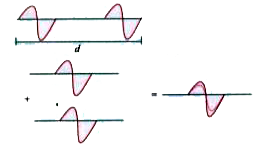Complete Solutions to CHALLENGING EXERCISE of chapter SOUND of Class 9 book with complete answers and questions
| Class 9 | PHYSICS |
| Chapter | SOUND |
| CENGAGE PHYSICS | CHALLENGING EXERCISE |
| Number Of Questions | 16 |
| Academic Year | 2023-24 |
A worker's helmet slips and falls when he is 78.4 m above the ground. He hears the sound of the helmet hitting the ground 4.23 seconds after it slipped. Find the speed of sound in air.
View SolutionThe speed of sound is 314 ms. The temperature of the surrounding atmosphere is -10°C. Calculate the speed of sound at (i) `-40^@C`.
[Hint: For every `1^@`C fall in temperature, the speed decreases by 0.6 m `s^(-1)`]View SolutionThe speed of sound is 314 ms. The temperature of the surrounding atmosphere is -10°C. Calculate the speed of sound at `40^@C`.
[Hint: For every `1^@`C fall in temperature, the speed decreases by 0.6 m `s^(-1)`]View SolutionA person standing between two vertical cliff's produces a sound. Two successive echoes are heard at 4 s and 6 s. Calculate the distance between the cliffs. [The speed of sound in air = 320 m `s^(-1)`]
View SolutionAn observer standing in front of a vertical wall claps 10 times in 1 s. He adjusts his distance from the wall in such a way that the sound of his clapping coincides with the echo. This happens when his distance from the wall is 17.5 m. What is the velocity of sound?
View SolutionHow many times more intense is a 90-dB sound than a 40-dB sound?
View SolutionWhat is the approximate distance of a thunderstorm when you note a 3-s delay between the flash of lightning and the sound of thunder?
View SolutionYou watch a distant person hammering a piece of iron at a regular rate of 1 stroke per second. You hear the sound of the hammer exactly synchronized with the blows you see. And then you hear one more blow after you see him stop hammering. How far away is he from you?
View SolutionCalculate the velocity of sound in a mixture of gases made up of 2 parts by volume of oxygen, one part by volume of carbon dioxide and 3 parts by volume of nitrogen, all volumes measured at NTP. `gamma=1.4` for nitrogen and oxygen and `gamma = 1.31` for carbon dioxide. R = 8.4 `J//"mole-K"`.
View SolutionShow that the velocity of sound in a gas is given by `v_t = v_(0) + (v_(0)//546) t`, where `v_(0)` is the velocity at `0^@C` and t is the temperature of the gas in `""^(@)C`. Assume `t lt lt 273`.
View SolutionA 5-watt source sends out waves in air at frequency 1000 Hz. Deduce the intensity at a 100-m distance, assuming spherical distribution. If `v= 350 m s^(-1)` and `rho= 1.3 kg m^(-3)`, deduce the displacement amplitude.
View SolutionA person is standing between two cliffs, suppose it takes at least t sec for an average human ear to differentiate between two sound waves. The person produces sound waves having velocity v, he is standing at distance `d_(1)` and `d_2` from the two cliffs. What is the relation between `d_(1), d_2`, v required so that he can distinctly hear both the echoes. What is the minimum value of `d_(1)` and `d_2` for the condition to happen?
View SolutionTwo waves are generated at the two ends of a string whose length is given to be d as shown in the diagram. It is known that they are going to interfere constructively after some time t as shown. What is t in term of the velocity of waves `v ge l`?
 View Solution
View SolutionWe are familiar with the formula velocity = `sqrt(("elastic property")/("density"))` Can you guess the elastic property and hence the velocity of sound waves in a rod having density `rho` and force constant k?
View Solution`lambda=(C_P)/(C_v)`, Find `gamma_(eq)`required for the mixture containing 1 mole of Gas A, 2 mole of Gas B such that `gamma` of `A= gamma_(1)` and `gamma` of `B= gamma_2` (and it is given that `C_P=C_V + R`)
View SolutionFind the minimum distance for echo in an atmosphere completely filled with dry `N_2` in a temperature of 300 K. Given `gamma` of dry `N_2 = 1.4, R = 8.314 "mol"^(-1) K^(-1)`
View Solution
CHALLENGING EXERCISE questions and complete solutions for chapter SOUND of CENGAGE PHYSICS of Class 9
All Exercises from CENGAGE PHYSICS Class 9 PHYSICS SOUND
- CHALLENGING EXERCISE
- CONSOLIDATED EXERCISE
- CONSOLIDATED EXERCISE(COMPREHENSION)
- CONSOLIDATED EXERCISE(EFFECTS OF TNTERFERENCE OF SOUND)
- CONSOLIDATED EXERCISE(MULTIPLE-CHOICE QUESTIONS WITH ONE OR MORE THAN ONE CORRECT ANSWER)
- GENERAL EXERCISE
- MANDATORY EXERCISE(EXERCISE SET I)
- MANDATORY EXERCISE(EXERCISE SET II)
- MANDATORY EXERCISE(EXERCISE SET III)
- MANDATORY EXERCISE(EXERCISE SET IV)
- OLYMPIAD AND NTSE LEVEL EXERCISE
- WORKED EXAMPLES
